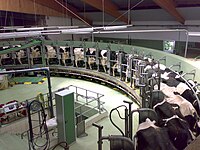
Photo from wikipedia
There is extensive literature addressing acceptable practices of colostrum distribution to new-born calves; however, no economic analyses are available concerning the profitability of this practice. Moreover, the health standards associated… Click to show full abstract
There is extensive literature addressing acceptable practices of colostrum distribution to new-born calves; however, no economic analyses are available concerning the profitability of this practice. Moreover, the health standards associated with colostrum management have been defined through the observation of reference farms without explicit reference to economic assessments. The objective of the current study was to evaluate the profitability of farm colostrum management and to define the optimal economic situations for given livestock systems and farm situations. The herd-level net value was calculated using the value of calf products, the cost of passive transfer failure and the cost of prevention. This value was determined for various beef and dairy scenarios and the various time periods spent managing colostrum. The maximal net values defined the optimal economic situations and enabled the determination of the optimal times for colostrum management and respective health standards (i.e., the prevalence of disorders at optimum). The results showed that the optimal time farmers should spend on colostrum management is approximately 15 min per calf. Furthermore, farmers should err on the side of spending too much time (> 15 min) on colostrum management rather than not enough, unless the cost of labour is high. This is all the more true that potential long term consequences of passive transfer failure on milk yields were not accounted for here due to scarcity of data, leading to consider this time threshold (15 min) as a minimal recommendation. This potential underestimation may arise from the greater nutrient content and bioactive compounds identified in colostrum although the passive immune transfer is here defined through immunoglobulins only. The present results show that for small farms that cannot hire colostrum managers, this work can be performed by the farmer after subcontracting other tasks. Moreover, the method proposed here—the definition of health standards through economic optimisation—is a promising approach to analysing health conventions in the cattle industry.
Journal Title: PLoS ONE
Year Published: 2018
Link to full text (if available)
Share on Social Media: Sign Up to like & get
recommendations!